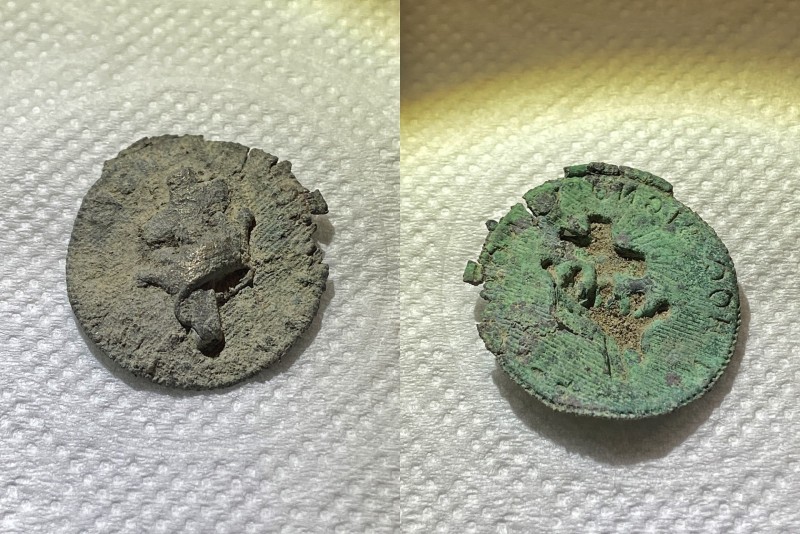-
Posts
1,931 -
Joined
-
Last visited
Content Type
Forums
Detector Prospector Home
Detector Database
Downloads
Everything posted by CPT_GhostLight
-
Congrats on your first hunt, Geologyhound, great finds, well done! The Silver Slayer program is great for coins, but as F350 noted, it will miss a lot of gold and even silver rings, depending on size and shape. You can change the notches on that, or any program to allow more of the gold range in. F350 also mentioned ways to determine some trash signal from good one. Big objects will usually ring in high and iron will false high on the Pitch audio. Raise the coil up to 6 inches on a loud high ringing suspect target. If it is something like a large can, it will sound the same as you raise the coil. If it is a high conducting coin or jewelry, the sound will fade fast as you lift. Also turn 90° on suspect targets as you sweep. Bad targets will usually change sound and ID drastically, but good targets usually sound good and ID the same as you turn. You should dig everything at first to learn how the D2 responds to each type of target. I still dig suspected trash targets from time to time just to verify them. A lot of what you know from your XLT will carry over into the Deus 2, it just has different ways of responding. As you get use to the sounds of the D2, you'll learn to hear slight differences in different types of targets which will help tremendously. There is so much to learn, but you are well on your way. 😎
-
XP 280 Backpack = Perfection On The Road
CPT_GhostLight replied to ColonelDan's topic in XP Deus II Forum
Thank you for that review, Colonel! I got my 280 long before I got my D2 and it accomodated my other detector well, but haven't flown with either yet. I actually never considered using the 280 to fly with and usually pack my detectors (all except the control pods) in a checked suitcase. I have to fly next month with the D2 and was wondering if I could put the coil in a checked bag or would have to carry it on with the control pod because of the internal batteries. I was considering getting the hard plastic case to carry on the whole D2, but your review convinced me I can use the 280 instead. Thank you again! -
I would suspect that a well known beach hunter has the update test beta version too, I don't know, but if the video leaks have started, then the roll out can't be too far behind. I'm looking forward to seeing what we get and hoping for the best. 😉
-
Well that was a hard fought and hard won button! Congrats, it's a beauty, well done! It's nice to see the D2 can handle the infamous red clay of Culpepper.
-
Decent Finds From Yesterday
CPT_GhostLight replied to Rob_R's topic in Metal Detecting For Coins & Relics
Congrats on the Wheaties, silver dime, and silver ring, well done! -
The Joy Of Not Finding Anything..
CPT_GhostLight replied to Erik Oostra's topic in Metal Detecting For Jewelry
You have a brilliant outlook Erik and good on you for saving the turtle. And of course that beautiful shell counts as a find too. I make non-metal finds that are just as interesting as metal finds and it all counts in my book. Well done! -
Found a sneak peak of the update...
-
For Those That Wanted A Waterproof Ws6 Master
CPT_GhostLight replied to CPT_GhostLight's topic in XP Deus II Forum
I don't know, but it looks like it has a membrane over the face so you should be able to press all the buttons. It looks like a pain to charge though. 😏 -
My First Relic Hunt With The Deus II
CPT_GhostLight replied to ColonelDan's topic in XP Deus II Forum
Good hunts for your first foray into relic hunting, Colonel! It definitely looks like some tough terrain. If your daughter's house is older, the I'd suggest looking for what might have been a dump or an outhouse (usually a small rectangular depression) near the house. People use to dump everything behind their houses and a dumpsite can provide many targets and some really good finds. Also look at the site on the Historic Aerials site to see what has changed over the years. It can give you good ideas for future searches. I agree with TJ, that rectangular piece looks like a gear frame (usually brass) for another clock, similar to the more complete one you found earlier. I'm drawing a blank on the rusty iron piece. I imagine it will feel good to get back out on your beaches after hunting in the rocky hills of Tennessee! Happy Hunting! -
Excellent! Remember, start with stock programs and get familiar with how they act before jumping into custom programs. They really are quite good straight out of the box. Try each one on some known targets to get a feel for how they react in your ground. The more you know about each program and each setting, the easier it will be to create custom programs that work the best in your ground.
-
A Little Leaf For The Pile
CPT_GhostLight replied to The Seeker's topic in Metal Detecting For Jewelry
Excellent hunt, Seeker, and that gold leaf is beautiful, well done! -
First off, excellent finds, GB_A, well done! I can't quite tell from your photo, but your naval button looks authentic and from the condition is probably newer. If the eagle is looking West, it is 1941-present date. If the eagle is looking East, it can be 1851-1941. As you found, the Waterbury Button Company (originally the Scovill Button Co. in Waterbury, Conn.) still makes these buttons as do many other companies for military, reenactors, and non military usage. My general opinion is that the ring does look gold, however, I can't tell from the photo if the stones were crimped prong set or glued in. If they were glued, I'd think it is not gold. Also a look at the stamp or hallmark would help to make a better guess. The bracelet looks funny to me. I was in the pawn business for 30 years and have seen a lot of fake jewelry, and without feeling it, it still raises some red flags for me. The stamp is suspect as is the general look of the metal. It is not uncommon to see silver plated brass and even stainless steel jewelry from Mexico with 925 stamps on them. Also the joining bands between the links should have soldered ends, not crimped if it is silver. Did you check it with a magnet? It's just a gut feeling and of course I could be wrong. Regardless, those are some great finds!
-
Very pretty piece and a nice find, congrats! There are a lot of jewelry makers here in Colorado who make these kinds of pieces for metaphysical, art, and Renaissance fairs and shops. They're also very popular with the new "hippie" generation. 😎
-
For Those That Wanted A Waterproof Ws6 Master
CPT_GhostLight replied to CPT_GhostLight's topic in XP Deus II Forum
Here's an updated video of this being used in the water. It looks like it works. Hopefully this guy will make a longer video with more information. -
For Those That Wanted A Waterproof Ws6 Master
CPT_GhostLight replied to CPT_GhostLight's topic in XP Deus II Forum
I don't know if these are for sale. It appears to be made by a Russian detectorist. It's a pretty cool idea if it works. -
My First Relic Hunt With The Deus II
CPT_GhostLight replied to ColonelDan's topic in XP Deus II Forum
Welcome to the wild and wonderful world of relic hunting, Colonel! Often, when my ears are being assaulted by rapid fire iron grunts and falses in a bed of square nails, I wonder why anyone in their right mind would want to do this. And then I find something really old and amazing that I could not have found in the city and remember why I do it. 😏 There's nothing wrong with notching iron out to get your ears used to this different style of detecting. Just be aware, if you notch too high, you can miss good targets masked by iron that drags their IDs really low. This is where the audio makes a difference. Trust the sound, not necessarily the ID. Good Hunting, Colonel! -
Which XP Deus 2 Coil Would You Choose For The Beach?
CPT_GhostLight replied to Detectornado's topic in XP Deus II Forum
I use the 9" all the time because it's the only one I have currently, but I haven't had the chance to beach hunt or hunt large farm fields with the D2 yet. That's really the only reason I'm considering a larger coil, for wider coverage. But for all the types of land hunting I do, I haven't really felt the need to go larger, except for maybe a bit more depth in some areas. The 9" is amazingly deep even in mineralized ground, easy on the arm, and has incredible separation. If I'm being honest with myself, I really don't even need a smaller eliptical coil at this point except to squeeze into smaller areas and between shrubbery. Of course if a 9x5" does come out, I will jump on it like a chicken on a junebug! 😉 -
I got my D2 last April and have had no problems with it other than learning it and that just takes putting in the hours on it like any other machine. My shaft has been great, with no flex problems like some report. So I'd recommend putting in as much time as you can and learn as much as you can about it. Fortunately it's so light that you can swing it all day and not get tired from it. After you get comfortable with it, and that won't take long, if you feel you need to make changes in shaft there are many after factory solutions, including a whole carbon fiber shaft. There may be quirks just like there are with all detectors and peripherals, but give it a chance to do it's thing first. The D2 is an amazing machine and it will amaze you too, the more you learn it. The most important thing I've learned about it so far is to learn the sounds and the audio nuances that can tell you so much more about targets than the TID numbers. And if you have questions or need help, there is no shortage of helpful and knowlegeable detectorists here that are always willing to help. Most of all just enjoy your new detector, it is a winner! 😎
-
Also, when paired with the D2, the MI-6 has 50 levels of sensitivity as opposed to 3 levels when not paired. You cannot use the vibration mode when paired, but I haven't really missed that at all. And you get 90 hours of battery runtime when paired, as well as all the audio choices F350 pointed out, MI-6 battery indicator and Target Zoom screen (which I never look at), and the kicker, the D2 can locate a lost MI-6 even when it is turned off. What's not to like? 😏
-
Another Day At The Big Farm With A Friend
CPT_GhostLight replied to F350Platinum's topic in XP Deus II Forum
We had one of those in our misc kitchen stuff drawer that my mother had for as long as I can remember. I never knew what it was. After yours and JCR's post, I told my wife that I finally figured out what that weird thing in the drawer was. She just looked at me and said, "Well, duh"... 🙄 I'll never figure out why women assume we know what they know. 😏- 17 replies
-
- coin found
- relic found
-
(and 1 more)
Tagged with:
-
Going Over Areas Multiple Times On The Beach
CPT_GhostLight replied to Sirius's topic in Metal Detecting For Jewelry
Here's the explanation that Minelab shows on their website. It is a simplified explanation, but basically correct. https://www.minelab.com/knowledge-base/getting-started/how-metal-detectors-work#:~:text=Metal detectors work by transmitting,electromagnetic field of their own. On VLF detectors, the electromagnetic field from the transmit coil is projected into the ground which does stimulate an EM field on the surface of any metal object in the range of the transmit coil's field, which varies by the target's conductivity, size, shape, and depth. The eddy currents that form on the metal object are weak and dissipate immediately after the target is out of the transmitted field. So, no, objects do not hold the charge created by the transmit coil's EM field. The receive coil detects the surface EM response of metal objects encountered within the transmit field, sending voltage variations back to the detector's electronics to be filtered and classified and translated into beeps, boops, and TIDs. That's it in a nutshell. -
Another Day At The Big Farm With A Friend
CPT_GhostLight replied to F350Platinum's topic in XP Deus II Forum
Well, congrats again, you certainly got something to crow about! 😉 I thought the wavey coin was a spur rowel too for a bit, but it has no pronounced bumps or points on the rim. I have to agree with JCR's wife and go with the wheel from a pastry cutter. That fancy buckle is very unusual and the other buckle, IHPs, and chicken are awesome as well. Well done again!- 17 replies
-
- coin found
- relic found
-
(and 1 more)
Tagged with:



